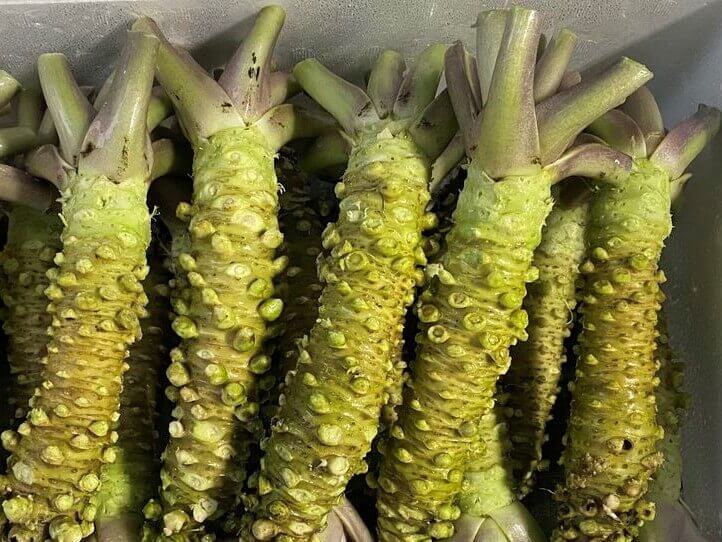 So, what is the true meaning of the shocking phrase, “Once you try tuna or flounder with this wasabi, you’ll never be able to eat it without wasabi again”?
So, what is the true meaning of the shocking phrase, “Once you try tuna or flounder with this wasabi, you’ll never be able to eat it without wasabi again”?
Wasabi is assessed by five points: its coloring, fragrance, stickiness, spiciness and sweetness. So does that mean this wasabi gets the highest marks for all these categories? In other words, when wasabi is grated, it’s a bright green color. The fragrance is fresh. It has a strong stickiness. The spiciness has a punch. After some time, it has a delicate sweetness.
The glorious thing about wasabi is that the vivid spiciness that goes through to the tip of your nose never lingers on your tongue or in your mouth. This lack of aftertaste is the biggest feature of wasabi’s delicious taste. The tastes of sashimi and sushi are subtle and delicate. Each cut of fish and each piece of sushi has its own unique and enjoyable flavor. If the wasabi were to linger on your tongue or in your mouth, it would get in the way of the next, new taste.
Furthermore, the potency of this spiciness is not what makes wasabi taste good. Good wasabi is spicy, but it also has a premium sweetness and refreshing fragrance at the same time. This is the true delicious taste of wasabi and it is a specific characteristic. Therefore, it is a superb spice for making good fish even more delicious.
Wasabi is native to the Japanese Islands and Sakhalin, Russia, is a perennial plant that belongs to the Brassicaceae family and is bred both by dividing roots for replanting and from seeds. The potato-shaped part that is normally grated and consumed, is part of the wasabi’s stem and called rhizome, just as potatoes have subterranean stems. Wasabi is broadly divided into red stem, which has a high anthocyanin content in the stems and blue stem, which has a low anthocyanin content. Mazuma (red stem), daruma (blue stem) and Shimane No. 3 (blue stem) are the three major types and it is known that most varieties that are currently cultivated were improved breeding from these. During the Edo period, daruma wasabi that was cultivated in Shizuoka was the most common, but then mazuma was introduced and became widespread, perhaps from degradation due to about 40 years of cultivation. Currently, mazuma seed cultivation only makes up about 30% of the total wasabi, even in Shizuoka, because the cultivation period of mazuma is longer than the seedling type and suitable places for planting have decreased, among other reasons.
The external appearance of mazuma is a dark green color and since there is purple on the base of the leaf, they are easy to distinguish by appearance alone. Since mazuma seeds mostly don’t fruit, the seedlings are cultivated by dividing the roots. It is difficult to ensure high quantity by dividing roots. Furthermore, it takes time to grow, so there is inevitably a rarity value.
The protrusions that occur with the growth of the surface are small and grow very close together, arranged in a spiral shape. This is the best wasabi of which the spiciness includes sufficient sweetness and that has a refreshing fragrance. On the market, it goes for US $50 to $200 per kilogram. Of course, it depends on the size, but one plant goes for about US $20. Wasabi is mainly produced on the Izu peninsula right now, but Yugashima, Amagi and Gotemba are known for mazuma. However, mazuma is actually native to Wakayama prefecture. It started in the Kawamata area of Inami Town in Wakayama, formerly known as Mazuma Village.
Related contents:
What is Yamawasabi?
[sc_apply url=”https://sushiuniversity.jp/apply/”]
We hope this information will be helpful.

Revision date: March 10, 2021
Share this article
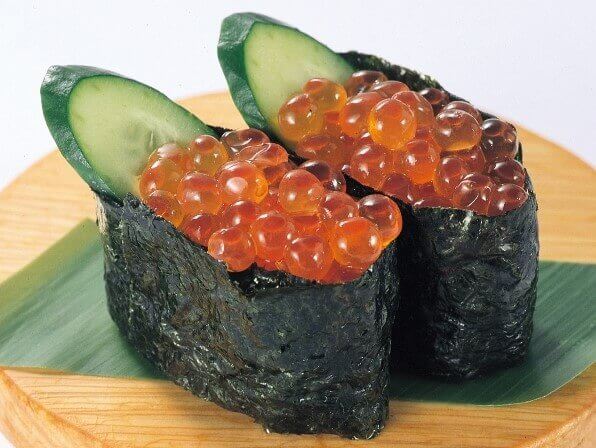 Immature salmon eggs still wrapped in ovarian membrane and salted are called sujiko. Ikura is salmon roe in which each mature egg is separated from the ovarian membrane before laying the eggs and then salted or marinated in soy sauce. The ikura of Chum salmon going upstream in the Kushiro River and Tokachi River in Hokkaido From October to December are considered to be premium ikura.
Immature salmon eggs still wrapped in ovarian membrane and salted are called sujiko. Ikura is salmon roe in which each mature egg is separated from the ovarian membrane before laying the eggs and then salted or marinated in soy sauce. The ikura of Chum salmon going upstream in the Kushiro River and Tokachi River in Hokkaido From October to December are considered to be premium ikura.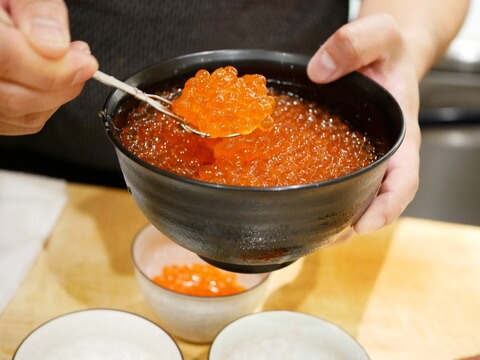 In Japan, salmon roe that has been separated from the ovarian membrane and then salted is called ikura. At sushi restaurants, this is also marinated in broth that includes soy sauce, mirin and sake. This is called ikura marinated in soy sauce, or simply ikura. Worldwide, caviar is considered to be of more value than ikura. Therefore, in an attempt to improve the impression of soy sauce-marinated ikura, it is sometimes called ‘salmon caviar’. This is behavior especially seen among manufacturers selling soy sauce-marinated ikura.
In Japan, salmon roe that has been separated from the ovarian membrane and then salted is called ikura. At sushi restaurants, this is also marinated in broth that includes soy sauce, mirin and sake. This is called ikura marinated in soy sauce, or simply ikura. Worldwide, caviar is considered to be of more value than ikura. Therefore, in an attempt to improve the impression of soy sauce-marinated ikura, it is sometimes called ‘salmon caviar’. This is behavior especially seen among manufacturers selling soy sauce-marinated ikura.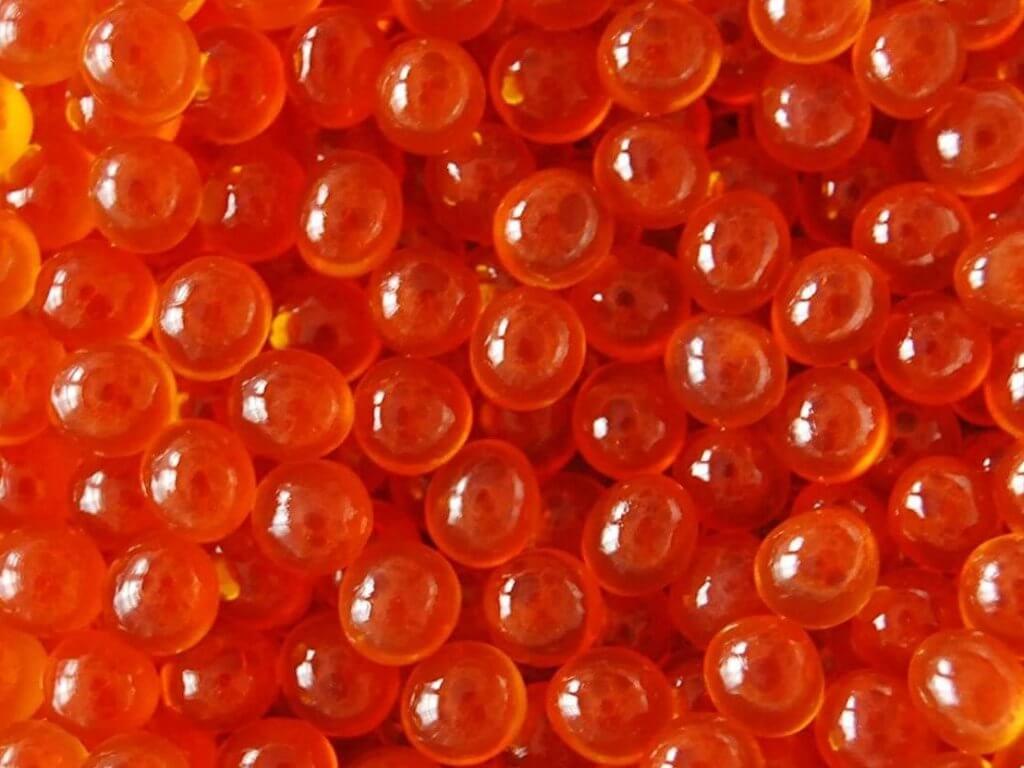 Not to belabor the point, but the following is dependent on the following. In Japanese salmon is referred to as “鮭” (sake/salmon) or “鱒” (masu/trout). The characters look different, but they are part of the same family and there aren’t clear biological categories to separate them into. Incidentally, in English the type that makes their way into the sea are called “salmon,” and those that remain in freshwater their entire lives are known as, “trout.” They are all considered to be part of the salmon family. Now, foreigners who know about Japan may imagine Japanese sake (the alcoholic beverage) when they hear the word “sake” so we spell sake/salmon as “shake”, which is close to the sound pronounced by Japanese people.
Not to belabor the point, but the following is dependent on the following. In Japanese salmon is referred to as “鮭” (sake/salmon) or “鱒” (masu/trout). The characters look different, but they are part of the same family and there aren’t clear biological categories to separate them into. Incidentally, in English the type that makes their way into the sea are called “salmon,” and those that remain in freshwater their entire lives are known as, “trout.” They are all considered to be part of the salmon family. Now, foreigners who know about Japan may imagine Japanese sake (the alcoholic beverage) when they hear the word “sake” so we spell sake/salmon as “shake”, which is close to the sound pronounced by Japanese people. Ken is considered to be better the longer and thinner it is, but this is a mistake. Not only is Ken tangled and difficult to eat, but it also doesn’t give any sense of the flavor of the materials. It’s long been said that 10 cm is a reasonable length and this is also the length that looks the most refined.
Ken is considered to be better the longer and thinner it is, but this is a mistake. Not only is Ken tangled and difficult to eat, but it also doesn’t give any sense of the flavor of the materials. It’s long been said that 10 cm is a reasonable length and this is also the length that looks the most refined.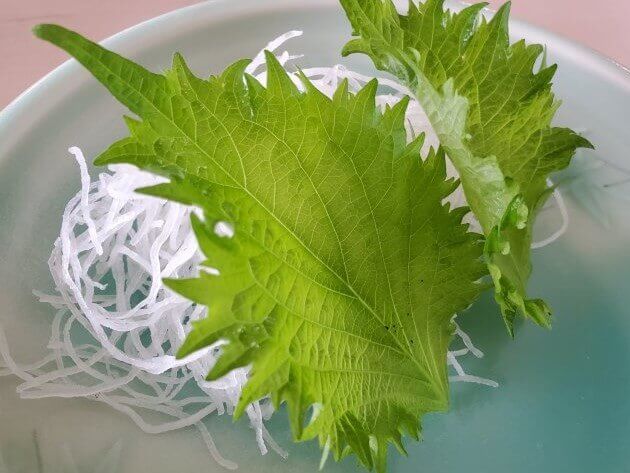 There are a few types of Tsuma. One is Shikitsuma (pronounced ‘shikizuma’ in Japanese) which consists of things like green shiso and cucumber leaves that sashimi is laid on. Another is Metsuma (pronounced ‘mezuma’ in Japanese) which is made from aome and murame. The final is Tatetsuma (pronounced ‘tatezuma’ in Japanese) used to prop sashimi up like hanahojiso and hanamaru kyuri. All Tsuma is served to bring out the charm of sashimi.
There are a few types of Tsuma. One is Shikitsuma (pronounced ‘shikizuma’ in Japanese) which consists of things like green shiso and cucumber leaves that sashimi is laid on. Another is Metsuma (pronounced ‘mezuma’ in Japanese) which is made from aome and murame. The final is Tatetsuma (pronounced ‘tatezuma’ in Japanese) used to prop sashimi up like hanahojiso and hanamaru kyuri. All Tsuma is served to bring out the charm of sashimi.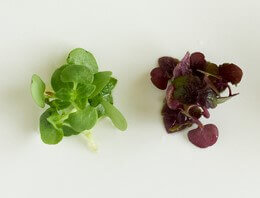
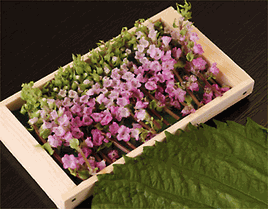
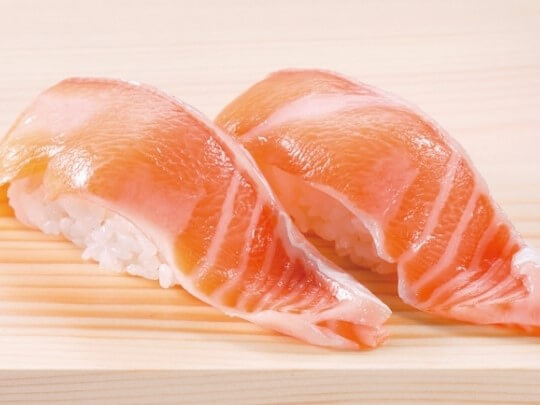 You probably already know this, but “toro tuna” is not the name of a type of fish. “Toro” is the name of a fatty part of the tuna. The fat content and attributes of the belly side of the tuna are completely different from that of the dorsal side. Toro is the name of the part near the head, mostly on the belly side.
You probably already know this, but “toro tuna” is not the name of a type of fish. “Toro” is the name of a fatty part of the tuna. The fat content and attributes of the belly side of the tuna are completely different from that of the dorsal side. Toro is the name of the part near the head, mostly on the belly side.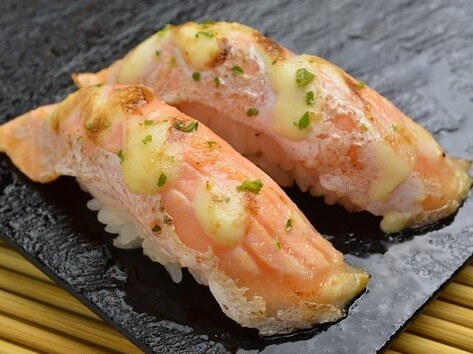 The Donaldson trout is farmed throughout Japan and is used as toro salmon and aburi salmon at conveyor belt sushi restaurants. Since they are supplied directly to the processor (of the salmon) from the farmer without going through the market, they may be sold cheaper than the import price. Just like the imported salmon, this farmed salmon is also fed artificial coloring. There are also already new variants improved from the Donaldson trout being bred. Trout made from breeding Donaldson trout females and steelhead males are called Donaldson steelhead, for instance. They grow even faster.
The Donaldson trout is farmed throughout Japan and is used as toro salmon and aburi salmon at conveyor belt sushi restaurants. Since they are supplied directly to the processor (of the salmon) from the farmer without going through the market, they may be sold cheaper than the import price. Just like the imported salmon, this farmed salmon is also fed artificial coloring. There are also already new variants improved from the Donaldson trout being bred. Trout made from breeding Donaldson trout females and steelhead males are called Donaldson steelhead, for instance. They grow even faster.